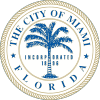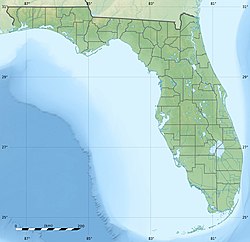
Back Miami Afrikaans Miami ALS ማያሚ Amharic Miami AN Mīamig ANG ميامي Arabic مايامى ARZ Miami AST Miami (Florida) Aymara Mayami Azerbaijani
Miami | |
|---|---|
|
| |
| Nicknames: The 305, Magic City, Gateway to the Americas, Gateway to Latin America, Capital of Latin America[1] and Vice City | |
 Interactive map of Miami | |
| Coordinates: 25°47′N 80°13′W / 25.78°N 80.21°W[2] | |
| Country | |
| State | |
| County | |
| Settled | After 1858[a] |
| Incorporated | July 28, 1896 |
| Founded by | Julia Tuttle |
| Named for | Miami River, ultimately derived from Mayaimi |
| Government | |
| • Type | Mayor–Commission |
| • Mayor | Francis Suarez (R) |
| Area | |
• Total | 56.07 sq mi (145.23 km2) |
| • Land | 36.00 sq mi (93.23 km2) |
| • Water | 20.08 sq mi (52.00 km2) |
| • Metro | 6,137 sq mi (15,890 km2) |
| Elevation | 6 ft (1.8 m) |
| Highest elevation | 42 ft (12.8 m) |
| Population | |
• Total | 442,241 |
• Estimate (2023)[7] | 455,924 |
| • Rank | 42nd in the United States 2nd in Florida |
| • Density | 12,284.47/sq mi (4,743.55/km2) |
| • Urban | 6,077,522 (US: 4th) |
| • Urban density | 4,884.8/sq mi (1,886.0/km2) |
| • Metro | 6,091,747 (US: 9th) |
| Demonym | Miamian |
| GDP | |
| • Metro | $483.755 billion (2022) |
| Time zone | UTC−05:00 (EST) |
| • Summer (DST) | UTC−04:00 |
| ZIP Codes | 33101–33102, 33106, 33109, 33111–33112, 33114, 33116, 33119, 33122, 33124–33138, 33140–33147, 33149–33158, 33160–33170, 33172–33199, 33206, 33222, 33231, 33233–33234, 33238–33239, 33242–33243, 33245, 33247, 33255–33257, 33261, 33265–33266, 33269, 33280, 33283, 33296, 33299 |
| Area code(s) | 305, 786, 645 |
| FIPS code | 12-45000 |
| GNIS feature ID | 277593, 2411786 |
| Website | www |
Miami,[b] officially the City of Miami, is a coastal city in the U.S. state of Florida and the county seat of Miami-Dade County in South Florida. It is the core of the Miami metropolitan area, which, with a population of 6.14 million, is the second-largest metropolitan area in the Southeast after Atlanta, and the ninth-largest in the United States.[9] With a population of 442,241 as of the 2020 census,[6] Miami is the second-most populous city in Florida after Jacksonville. Miami has the third-largest skyline in the U.S. with over 300 high-rises,[11] 61 of which exceed 491 ft (150 m).[12]
Miami is a major center and leader in finance, commerce, culture, arts, and international trade.[13][14] Miami's metropolitan area is by far the largest urban economy in Florida, with a 2017 gross domestic product of $344.9 billion.[15] In a 2018 UBS study of 77 world cities, Miami was the third-richest city in the U.S. and the third-richest globally in purchasing power.[16] Miami is a majority-minority city with a Hispanic and Latino population of 310,472, or 70.2 percent of the city's population, as of 2020.[17]
Downtown Miami has among the largest concentrations of international banks in the U.S. and is home to several large national and international companies.[citation needed] The Health District is home to several major University of Miami-affiliated hospital and health facilities, including Jackson Memorial Hospital, the nation's largest hospital with 1,547 beds,[18] and the Miller School of Medicine, the University of Miami's academic medical center and teaching hospital, and others engaged in health-related care and research. PortMiami, the city's seaport, is the busiest cruise port in the world in both passenger traffic and cruise lines.[19]
The Miami metropolitan area is the second-most visited city or metropolitan statistical area in the U.S. after New York City, with over four million visitors in 2022.[20] Miami has sometimes been called the "Gateway to Latin America" because of the magnitude of its commercial and cultural ties to Latin America.[21] In 2022, Miami ranked seventh in the U.S. in business activity, human capital, information exchange, cultural experience, and political engagement.[22]
- ^ "Miami: the Capital of Latin America". Time. December 2, 1993. Archived from the original on December 24, 2007.
- ^ "US Gazetteer files: 2020". United States Census Bureau. March 25, 2021. Archived from the original on August 24, 2019. Retrieved March 25, 2021.
- ^ George, Paul S. (1996). "Miami: Three Hundred Years of History". HistoryMiami. Archived from the original on July 28, 2021. Retrieved May 28, 2021.
- ^ Shappee, Nathan D. (1961). "Fort Dallas and the Naval Depot on Key Biscayne, 1836–1926" (PDF). Tequesta. 21: 13–40. Archived from the original (PDF) on August 26, 2021. Retrieved May 28, 2021 – via Florida International University Digital Collections.
- ^ "2020 U.S. Gazetteer Files". United States Census Bureau. Archived from the original on March 18, 2021. Retrieved October 31, 2021.
- ^ a b "P2: HISPANIC OR LATINO, AND NOT ... - Census Bureau Table". P2 | HISPANIC OR LATINO, AND NOT HISPANIC OR LATINO BY RACE. U.S. Census Bureau. Archived from the original on March 22, 2023. Retrieved March 21, 2023.
- ^ "Annual Estimates of the Resident Population for Incorporated Places in Florida: April 1, 2020 to July 1, 2022". Florida. U.S. Census Bureau. May 2023. Archived from the original on June 24, 2023. Retrieved May 27, 2023.
- ^ "List of 2020 Census Urban Areas". census.gov. United States Census Bureau. Archived from the original on January 14, 2023. Retrieved January 8, 2023.
- ^ a b "2020 Population and Housing State Data". United States Census Bureau. Archived from the original on August 24, 2021. Retrieved August 22, 2021.
- ^ "Total Gross Domestic Product for Miami-Fort Lauderdale-West Palm Beach, FL (MSA)". Federal Reserve Economic Data. Archived from the original on January 12, 2024. Retrieved January 26, 2024.
- ^ "US Cities With the Most Skyscrapers". WorldAtlas. February 6, 2018. Archived from the original on June 19, 2019. Retrieved June 18, 2019.
- ^ "The Skyscraper Center: Buildings in Miami". skyscrapercenter.com. CTBUH. Archived from the original on July 2, 2019. Retrieved June 18, 2019.
- ^ "The World According to GaWC 2008". Globalization and World Cities Study Group and Network, Loughborough University. Archived from the original on August 11, 2016. Retrieved March 3, 2009.
- ^ "Inventory of World Cities". Globalization and World Cities (GaWC) Study Group and Network. Archived from the original on October 14, 2013. Retrieved December 1, 2007.
- ^ "Gross Domestic Product by Metropolitan Area, 2017" (PDF). Bea.gov. Archived (PDF) from the original on October 9, 2022. Retrieved October 23, 2018.
- ^ "City Mayors: Richest cities in the world". www.citymayors.com. Archived from the original on March 23, 2019. Retrieved June 18, 2019.
- ^ "P2: HISPANIC OR LATINO, AND NOT HISPANIC OR LATINO BY RACE". 2020 Census. United States Census Bureau. Archived from the original on October 16, 2021. Retrieved October 10, 2021.
- ^ "100 of the largest hospitals and health systems in America". Becker's Hospital Review. July 2010. Archived from the original on June 2, 2022. Retrieved June 4, 2022.
- ^ "PortMiami 2017 Cruise Guide" (PDF). Archived (PDF) from the original on January 28, 2018. Retrieved June 18, 2019.
- ^ "US Cities and States Visited by Overseas Travelers". International Trade Administration. September 27, 2023. Archived from the original on February 19, 2024. Retrieved February 20, 2024.
- ^ "Florida: Gateway to Latin America and the Caribbean" (PDF). September 2017. Archived (PDF) from the original on July 7, 2021. Retrieved November 29, 2021.
- ^ "2019 Global Cities Report". ATKearney. Archived from the original on April 25, 2024. Retrieved June 18, 2019.
Cite error: There are <ref group=lower-alpha> tags or {{efn}} templates on this page, but the references will not show without a {{reflist|group=lower-alpha}} template or {{notelist}} template (see the help page).













